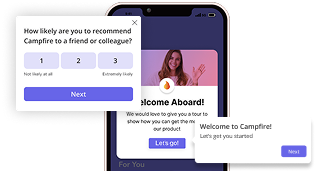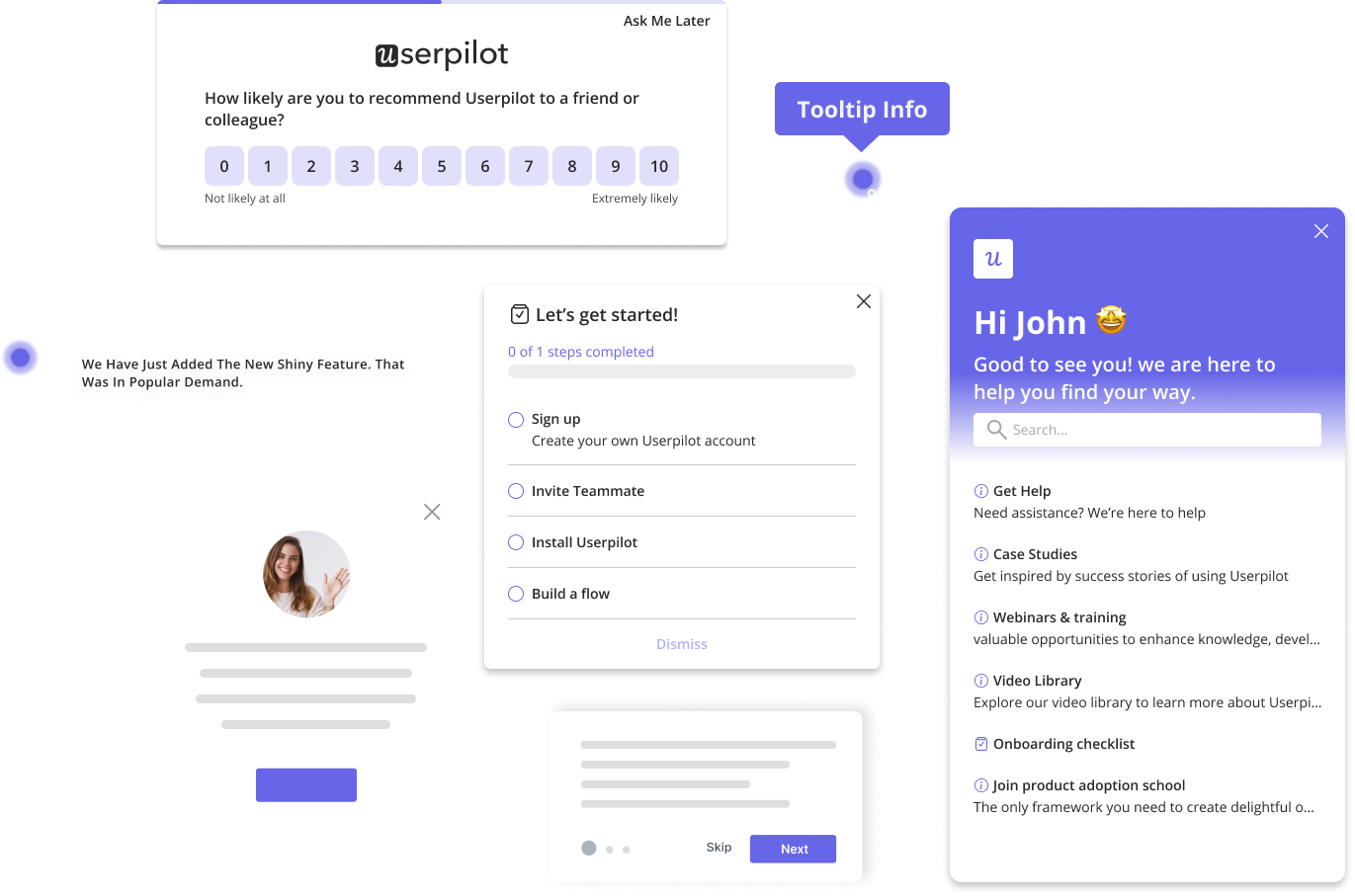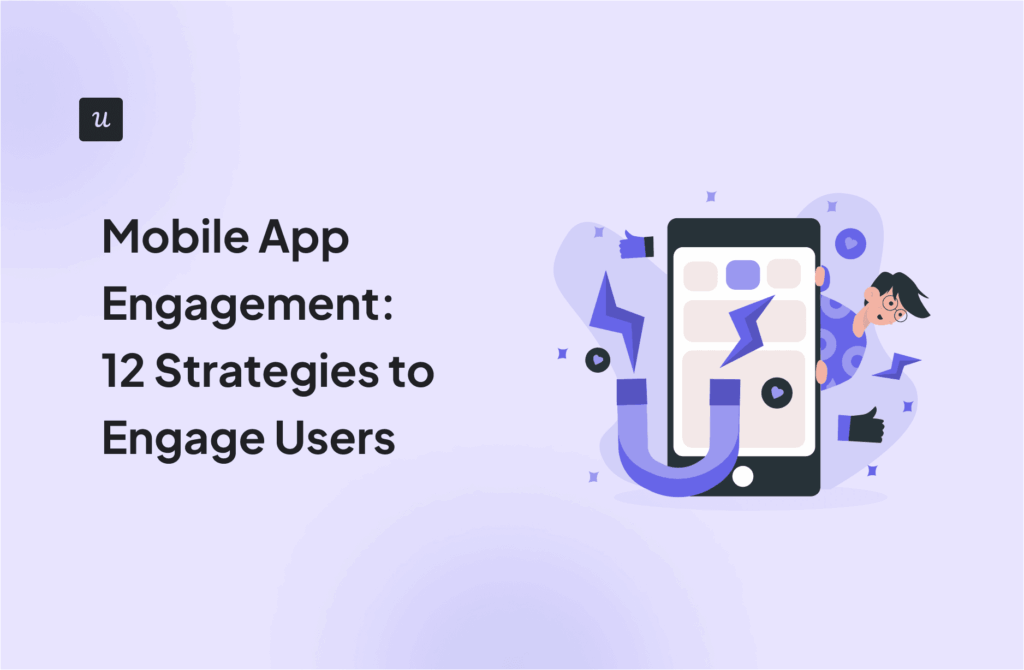
A new user just signed up for your app. They log in, excited to explore, only to be met with: Nothing. No welcome screen, tooltips, popups, or announcements… no form of in-app guidance.
They click around but don’t really know where to start. They’re just staring at an empty interface without any onboarding direction or support options.
Frustrated, they exit the mobile app, probably for good.
This is exactly why mobile in-app messaging matters, so your user experience doesn’t end up feeling clunky and impersonal. This article will help with that, discussing nine best practices for improving your app messages.
Try Userpilot Now
See Why 1,000+ Teams Choose Userpilot

Why implement an in-app messaging strategy?
Mobile in-app messaging enjoys a staggering 75% open rate, 45x more than email and 3x greater than push notifications. What does that tell us? That in-app messaging is great for driving user engagement compared to other forms of customer communication, among other benefits.
- Timely, personalized communication: Send in-app messages based on user behavior to increase meaningful engagement. For instance, for users regularly engaging with a feature, a pop-up could offer them a personalized tutorial or advanced tips to improve their experience.
- Improve conversion rates: Well-timed in-app messages are ideal for prompting users to take specific actions, such as completing onboarding or exploring new features. Research shows that in-app messages enjoy 8x more response rates than push notifications.
- Psychologically effective: Unlike push notifications, in-app messages appear when users are most engaged with your app. This drives the chances of them noticing, appreciating, and responding to the app messaging.
- Non-disruptive, omnichannel experience: Users typically switch between web and mobile to access most apps. Your job is to make sure the experience is consistent across both so users don’t get confused. In-app messages help build this continuity, connecting with users where they are in the mobile app without disrupting their experience.
9 Best practices to create a positive user experience for app users
With over 42,000 new apps launched every month, companies need to perfect the in-app experience if they want to retain users. But the question is, how can you improve the experience for yours?
1. Personalize messages to engage users
71% of users expect personalized interactions and get frustrated when that doesn’t happen.
Tailoring app messages to individual users based on their behavior, preferences, or customer journey stage. Or try content localization to cater to users from different regions by translating content into their language and adapting to cultural nuances.
Personalizing messages this way makes users feel valued because you acknowledge their needs and provide content accordingly.
The easy way to implement such in-app messaging is through tools like Userpilot. These tools help personalize experiences based on multiple criteria, such as user attributes, segments, behavior, language preferences, and more.

2. Send relevant messages at relevant times
Time your in-app messages right for maximum likelihood of engagement.
For example, send a welcome message guiding users through the onboarding process right after they sign up. Or, trigger a reminder about an expiring trial when a user is actively exploring premium features, encouraging them to upgrade.
This way, your messages are more contextually relevant, and you avoid bombarding users with information at inconvenient times.

3. Use concise language
“To get the most out of your app experience, it’s important to fully explore all the features and customization options available in your account to enhance productivity and make the app more suited to your needs.”
vs.
“Explore features and settings to customize your in-app experience and boost productivity.”
Which one reads better?
The latter, right? Because it’s clearer, concise, and easy to understand at a glance. Just like your mobile in-app messaging needs to be, especially since all the text will be displayed on a smaller mobile screen.
If you need help simplifying all this writing, try AI writing tools, such as Userpilot’s AI writing assistant, which can generate content from scratch or refine and perfect existing content to your needs.

4. Promote new app features
Use in-app messaging to introduce new features and roll out feature announcements or updates. This keeps users aware of improvements so they can take full advantage of them, encouraging feature adoption in the process.
Think about it: When are you more likely to try out a new feature? When you get an email about it, or when you’re in-app and a pop-up suggests a relevant feature. Like most of us, you’d go for the second option because that’s when you’re most engaged and willing to explore.
To build announcements optimized for mobile apps, try Userpilot. It helps you entirely customize announcements, from the theme, positioning, layout, colors, and more.

5. Boost product adoption
Use in-app messaging to offer guidance or support users through features they might not be familiar with. For example, when a user opens one of your advanced features for the first time, trigger an in-app message asking if they need help and suggesting useful resources.
Sending such helpful messages at the right moment can make users feel supported, reducing user frustration and improving product adoption.
6. Ask for user feedback
Mobile in-app messaging can also help you learn more about users and their in-app experience by asking them for feedback.
So, try launching different in-app surveys, like NPS, CSAT, CES, etc., to prompt users to give qualitative feedback. Especially target active app users since they’re the most engaged and can provide useful insights on key app features.
Build customized in-app surveys with Userpilot without any coding and trigger them for specific user segments.

7. Be transparent with your app messaging
Use in-app messages to inform users about important changes, such as policy updates, bug fixes, or upcoming system maintenance.
But why communicate any of this at all?
Let’s go over a simple scenario to answer that question.
Your user is in the middle of generating a report when suddenly everything stops. Most likely some scheduled system maintenance, but the users don’t know that. How would they? There’s no error message or in-app guidance, just silence. And this silence just ruined the user experience.
Instead, save users from such disruptions and manage expectations better by timely communicating through in-app messages.
8. Monitor and analyze performance
Track how users engage with your in-app messages to see what you’re doing right and uncover pain points.
For example, what if users aren’t interacting with the pop-up prompting them to try a new feature? It could indicate the message isn’t clear or the feature isn’t relevant, hinting at a flaw in your segmentation.
However, tracking messaging performance shouldn’t just be limited to mobile apps. You need to consider both web and mobile. Because often, users start their journey on web apps but switch to mobile for convenience. So you need a tool that analyzes both channels for a holistic view of performance.
One such recommended tool is Userpilot, which provides a single source of truth for analytics across web and mobile. Plus, Userpilot for Mobile makes sure that onboarding flows, feature announcements, and messaging are aligned across both platforms. So, even if a new user skips onboarding on the web, they can see an in-app message prompting them to complete it when they log in via mobile.

9. Test and optimize
To drive greater engagement, continuously test and improve your in-app notifications and messaging.
The changes don’t even need to be that big; just try using different message formats, timings, and content to see what resonates best with your users. For example, test which performs better between a banner message vs. a pop-up for a product update.
Level up your app experience with smart in-app messaging
If there’s one thing you remember from this article, let it be this: Mobile in-app messaging works best when it’s timely, relevant, and personal.
So, take the time to refine your messaging, experimenting along the way to see what works and what doesn’t. Tailor your messages to users’ needs and context, guide them through new features, and keep collecting feedback so you know how you’re performing.
Ready to refine your in-app messaging across web and mobile apps? Book a Userpilot demo today and see how to personalize messages, run A/B tests on them, track their performance, and more.








